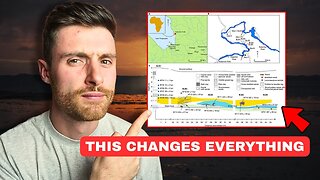Premium Only Content

Curiosity Rover Finds New Clues to Mars' Watery Past
Curiosity, which landed on Mars in 2012, is currently exploring a unique feature known as the “Marker Band” in the foothills of Mount Sharp. Rocks in this area show the clearest evidence yet for waves the mission has ever seen: rippled textures that formed billions of years ago, as waves on the surface of a shallow lake stirred up sediment on the lake bottom.
Farther up the mountain, Curiosity can see more evidence of ancient water: wet landslides caused boulders and other debris to slip down into a valley. Curiosity caught a glimpse of this debris from a distance, but the rover's team hopes to get a closer look later in 2023.
For more information on NASA's Curiosity rover, visit mars.nasa.gov/msl.
TRANSCRIPT
Ashwin Vasavada
Curiosity Project Scientist
The Curiosity rover has discovered lots of evidence of ancient lakes on Mars. But what we saw in this panorama surprised us! Curiosity is currently exploring Mount Sharp. You can see the upper part of the mountain here.
The whole mountain is 3-miles-tall, but we’re down in the foothills. In 2022, the rover started exploring a unique feature on Mars called the Marker Band. It is a dark, thin layer of rock that stands out from the layers above and below it. We first saw it in orbiter images years before we launched.
What created this winding layer of hard rock is a mystery. But Curiosity can help us understand what formed the Marker Band. We first discovered that the rocks within the Marker Band are really hard.
Curiosity has faced some challenges drilling into them. But we might find a softer spot on the road ahead. Nearby we found an exciting scientific clue. These rippled textures were created billions of years ago by waves in a shallow lake.
We’ve climbed through many lake deposits during our mission, but have never seen wave ripples this clearly. This was especially surprising since the area we’re in probably formed at a time when Mars was becoming more dry. Just above the rippled layer is another intriguing clue. These rocks have a very repetitive pattern in their spacing and thickness.
We see lots of layers on Mars, but they’re rarely this regular. We’re not sure what caused this rhythmic pattern. Weather or climate cycles, like dust storms happening at periodic intervals, are possible explanations.
Look at these gorgeous layered hills and cliffs that Curiosity is headed toward. They would be a national park on Earth! In the distance here, we can see debris in a valley called Gediz Vallis. This was washed down here by wet landslides very late in Mount Sharp’s history.
This material is probably the most recent evidence of water that we’ll ever see. The landslide debris allows us to study layers higher up on Mount Sharp that we can’t reach since they're so far up the mountain.
Curiosity has driven through some amazing scenery and we’ve learned so much about Mars’ ancient climate. But even after ten years, there’s much more to explore!
-
 LIVE
LIVE
Donald Trump Jr.
1 hour agoLawless Lawfare and the Meme Wars. Interviews with Alex Swoyer & Doug Mackey | TRIGGERED Ep.262
9,883 watching -
 LIVE
LIVE
BonginoReport
1 hour agoSydney Sweeney Makes America Hot Again & Triggers The Libs! - Hayley Caronia (Ep.99)
3,981 watching -
 LIVE
LIVE
Dr Disrespect
7 hours ago🔴LIVE - DR DISRESPECT - WARZONE - RAGE ON THE MAIN STAGE
6,531 watching -
 53:29
53:29
Candace Show Podcast
2 hours agoEXCLUSIVE! Brigitte Macron's Lawyer Has A Dark Past. Dan Bongino Speaks Out. | Candace Ep 220
23.1K77 -
 1:18:11
1:18:11
Redacted News
2 hours agoScotland is being DESTROYED and Neil Oliver is trying to save it
14.8K40 -
 20:38
20:38
Exploring With Nug
8 hours agoMissing Tennessee Man Found Crashed in Ravine — Could He Have Been Saved!
2691 -
 LIVE
LIVE
Vedic compatability astrology
2 hours ago"Aleta ST James:The Woman Who Tried to Conquer Time Itself"
158 watching -
 36:36
36:36
Kimberly Guilfoyle
3 hours agoTrump Trade Wins, Live with Daniel Turner & Jarrett Stepman | Ep241
82.6K16 -
 13:16
13:16
Michael Button
8 hours agoWhat If We’re NOT the First Smart Humans?
5.69K4 -
 LIVE
LIVE
The Amber May Show
2 hours agoShattering the Narrative: Trump, Media Collapse & The Rising Chaos
143 watching